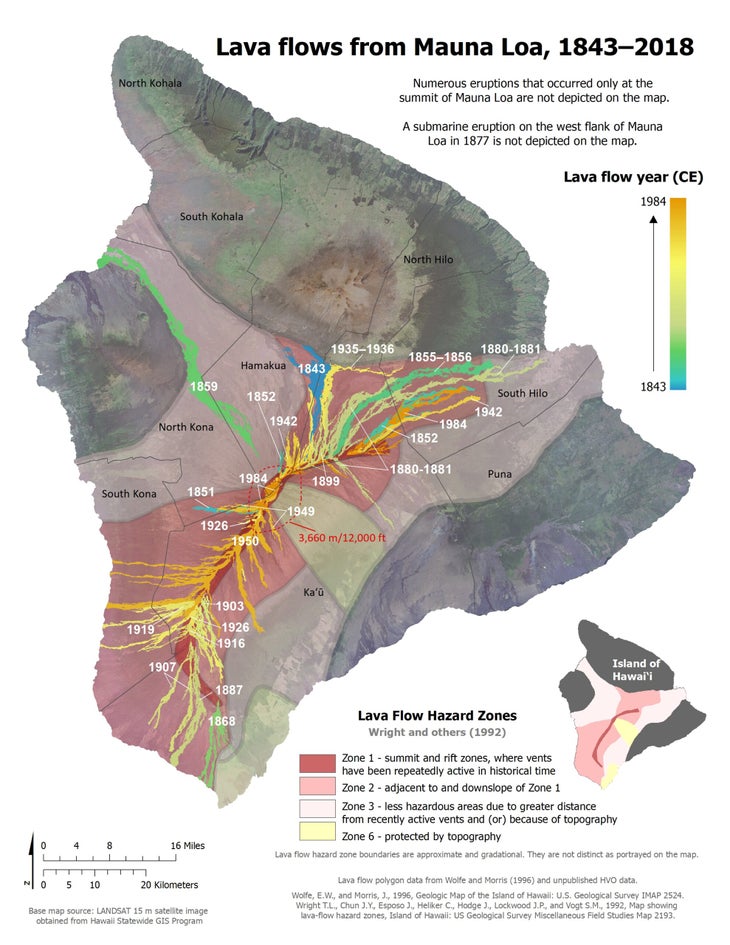New perk! Get after it with local recommendations just for you. Discover nearby events, routes out your door, and hidden gems when you sign up for the Local Running Drop.
Beginning approximately 11:30 p.m. on Sunday, November 27, Mauna Loa, the world’s largest active volcano erupted, according to data from the U.S. Geological Service after a series of earthquakes. Located on the Big Island of Hawaii, Mauna Loa sits approximately 30 miles as the bird flies, but roughly a 2-hour-plus drive from the home of the site of the Ironman World Championships. Reports from the USGS said a “steaming fissure was active during the beginning of the eruption, but [by Monday morning] the lava in the summit caldera had already cooled to a black color.”
While the previous eruption sent a flow of lava within five miles of Hilo on the island’s east coast, the U.S. Geological Service (USGS) said that this time there was no immediate threat to residents, but toxic volcanic gas, such as sulfur dioxide, and ash might drift in their direction.
It also warned people to stay vigilant because an eruption “can be very dynamic, and the location and advance of lava flows can change rapidly.”
An erupting volcano can send lava as high as 200 feet into the air from fissures at the crater.
Around 200,000 people live on the Big Island and Hawaii’s Emergency Management Agency has opened two shelters—in Pahala and Kailua Park—as a precaution but has not issued any evacuation orders.
Mauna Loa sits at 13,679 feet (4,169 meters) and is part of the chain of volcanoes that formed the islands of Hawaii. The eruption followed a series of sizeable earthquakes. Mauna Loa is also the much larger neighbor of Kilauea, which erupted and destroyed 700 homes in 2018.
The Hawaii Emergency Management Agency further reiterated that there is no lava threat to the population, however the USGS Hawaiian Volcano Observatory has escalated their alert level from “advisory” to “warning.”
Mauna Loa, which last erupted 38 years ago, has not historically had any direct lava impact on the town of Kailua-Kona—the location of the Hawaii Ironman World Championships—according to the USGS, as lava flows are typically diverted around the nearby volcano of Hualālai. However, air quality for the town and surrounding areas can be a concern, due to ash and levels of sulfur dioxide, noted the Hawaii Department of Health.
While lava flows aren’t currently an issue during this eruption, Mauna Loa’s lava has had a distantly historic impact on certain parts of the Hawaii Ironman World Championship course. Way back in 1859, a large, 300-day eruption produced a 32-mile lava flow that extended northwest across the Big Island and met the ocean near Kiholo Bay, crossing what’s now the site of the bike course on the Queen K Highway, running midway between where the airport is today and the community of Waikoloa Village.

The last time Moana Loa erupted was six months before Dave Scott beat Scott Tinley for the fourth of his six Ironman world titles, with an 8:54 finish that was the first time a triathlete had broken nine hours in Hawaii.
It was also the year Canadian Sylviane Puntous defeated her sister Patricia for the second successive year.
Pro triathlete Laura Siddall, who finished 10th in Kona this year, was part of Ultraman competitor, Dede Greisbauer’s support team whose travels around the island included staying overnight in the Volcano national park last Friday and was still on the island.
“We did a recce of the race course a couple of weeks ago and I was complaining how it was false advertising at Volcano,” she said. “It’s a lesson to be careful what you wish for!
“It’s fire and ice here. Mauna Loa is erupting while Mauna Kea at the top of the island is covered in snow.
“Kona is currently deemed a safe zone because the lava isn’t predicted to come this way, but there is an air quality warning.
“It was a cloudy day yesterday anyway, but it’s hard to tell whether that’s volcano-related given the weather has been mixed. I went for a cycle and didn’t feel there was a problem with air quality.
“Everyone seems to be going around as if it’s business as usual, but there’s obviously a ‘have you heard the news’ vibe?’”
“I was at the Ultraman awards last night and coming back in a taxi to Kona, our driver was keen to go and see it. Another local asked if I wanted to go on a helicopter ride! There’s definitely some intrigue.
Siddall also explained how the Ultraman course already had to be changed due to the 2018 flow that left a 40ft wall of lava.
For more information and up-to-date alerts, please visit the Hawai‘I County Civil Defense Agency’s website.
This is a developing story, and will be updated with more details as they become available.

